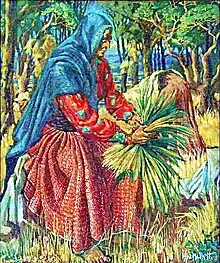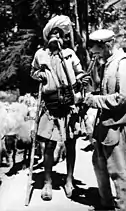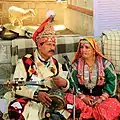Gaddis
The Gaddi is a semi-pastoral Indo-Aryan ethno-linguistic tribe living mainly in the Indian states of Himachal Pradesh and Jammu and Kashmir.
.jpg.webp)

Overview
The origin of the Gaddi Tribe is unclear. Their oral history includes stories of their ancestors fleeing from the plains to a hillier region in search of security against foreign invasions. These may only be popular myths; there is no academic consensus about their origin.
The Gaddi nomenclature springs from the word "Gaderan", the native word for the hilly tracts of Himachal Pradesh. Gaddis, a Scheduled Tribe of Himachal Pradesh, are found principally focused in Bharmauri of Chamba district, an area popularly called ‘Gaderan’ which means ‘the home of the Gaddis’. Bharmour is additionally known as the abode of Gaddis. The term "Gaddi" conjointly refers to a territorial cluster of a special category of individual forming an exogamous union of Brahmin, Rajputs, Khatris and other castes whose primary traditional occupations were agriculture and goatherding. The word ‘Gaddi’ derives from the Sanskrit word "Gabdika" (गब्दिक), an Ancient Tribal Republic mentioned in Paninis Ashtadhyayi, where present day Gaddis live. Many believe that Kailash is the throne (gadi) of the Lord Shiva, and that therefore, those people who took refuge and settled in Brahmaur also came to be referred as Gaddis.
Gaddis are semi nomadic, semi-agricultural and a semi-pastoral tribe. They have a defined culture, expressed through language, dress, food, marriage, song, and devout celebrations. Gaddis have their imperial history deep-rooted in their culture. In order to preserve their cultural heritage, they take pride in their culture and maintain cultural coherence from generation to generation. Gaddi is the language of Gaddi community and Tankri is the script used by the old people of the community. Other people spoke Hindi, whereas Devanagari is used as a script.
The caste system prevalent in the Gaddi community. Some are Gaddi Rajput and some are Gaddi Brahmin which are also called Bhatt Brahmin. They came in Chamba during the reign of Ajai Verma in the 8th century. They believe they are descendants of Lord Shiva. They also believe in Lord Kartikeya (kelang), gugga and awtars. Nuala is a holiday celebrated by this community, in which they offer sheep to Lord Shiva, chant the aincheliya, and dance all night.
According to the 2011 Census of India, the Gaddi population was 178,130 in Himachal Pradesh and 46,489 in Jammu Kashmir. The Gaddis of Himachal Pradesh had an adult sex ratio of 1014 and literacy rate of 73.3, whereas those of Jammu and Kashmir had a sex ratio of 953 and literacy of 53.5. They are classified as a scheduled tribe in both areas under India's reservation system.[1]
Gallery
 Gaddi woman cutting grass. Painting by Alfred Hallett c. 1980
Gaddi woman cutting grass. Painting by Alfred Hallett c. 1980
 Gaddi artisans at Suraj Kund fest
Gaddi artisans at Suraj Kund fest
References
- "Statistical Profile of Scheduled Tribes in India" (PDF). Registrar of Census, Government of India. p. 170. Retrieved 1 May 2019.
Further reading
- Verma, V. 1996. Gaddis of Dhauladhar: A Transhumant Tribe of the Himalayas. Indus Publishing Company, New Delhi.